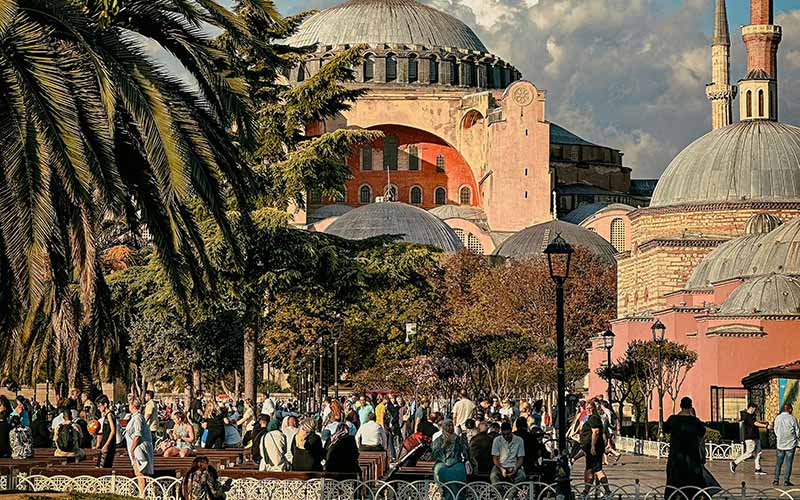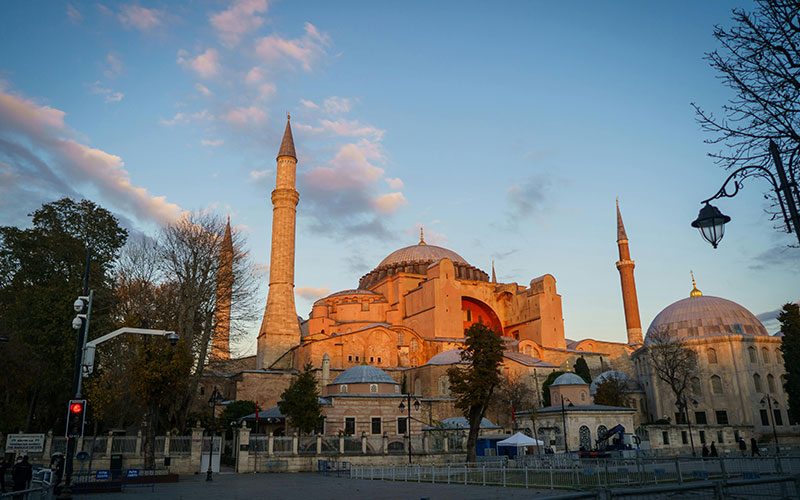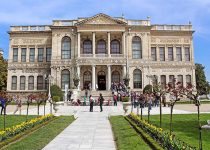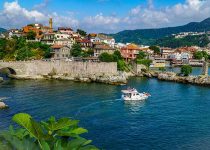Hagia Sophia in Istanbul: History, Architecture, and Cultural Significance
Hagia Sophia, the emblematic Istanbul landmark, is a brilliantly magnificent representation of the profound history and culture of this city. Established in AD 537 as a cathedral, rehabilitated into a mosque, and presently operating as an exquisite museum, it presents the sightseer with splendid architecture and elaborate mosaics. Its extraordinary construction is a merge of Byzantine and Ottoman forces, a destination for the majority to be in awe at and observe the stateliness of its history.
Historical Timeline of Hagia Sophia
The reflective history of Hagia Sophia is quite extensive and can be easily exemplified by the transitions of Istanbul’s cultural and religious life. This grand construction was erected in 537 after the demolition of the main church at the time of the Nika unrest, by which the original structure was altered into an astounding cathedral, becoming the world’s biggest and the largest center of Orthodox Christianity. Hagia Sophia later became an exquisite mosque with a mihrab and minbar. Striking calligraphy was added after the Ottoman conquest in 1453. Then, Mustafa Kemal Atatürk converted the same into a lovely museum in 1935, featuring a blend of magnificent Christian mosaics and Islamic themes. In 2020, the UNESCO-famed spectacle returned to the stature of a mosque, thus continuing its function as a monument to the living vibe of the convergence amid faiths and cultures.
Construction & Architectural Journey

Hagia Sophia’s construction was initiated in 532 AD and closed in 537 AD by Emperor Justinian I. It was envisioned by the brilliant architects Anthemius of Tralles, along with Isidore of Miletus, and it boasted ground-breaking architectural practices, like a central dome hovering in space and supported with piers and buttresses. The outer walls were bedecked with mosaics and plentiful marble columns, while its interiors were richly bedecked with superb marble panels and glitzy gold leaf within lively sacred mosaics, making it the largest cathedral ever built for almost a millennium. One of its greatest accomplishments here is a piece of the Hagia Sophia history; it is a construction wonder, demonstrating distinct ingenuity and implication in culture.
Architecture & Layout
Dubbed one of the best historical sites in Turkey, Hagia Sophia’s architecture typifies the merging of Eastern and Western elements, thanks to its eventful history of over 1,500 years. Built by Emperor Justinian I, it was intended to be built in the 6th century. Its most remarkable feature is the massive dome, with a diameter of 102 feet and soars about 180 feet. Its brilliant architectural innovation does not demand support columns. The interior has elaborate mosaics and other decorations, which make it a timeless masterpiece that continues to inspire visitors.
Revered Christian Cathedral
With Hagia Sophia’s completion in 537, it remained a charming Christian cathedral until 1453. It was commissioned by Emperor Justinian I for about a millennium. Its splendor, symbolized by striking mosaics and a spectacular dome, befits one who was all at once a monarch, an emperor, and a state-theology church. Hagia Sophia was designated as a church and remained a sacred site until the Ottoman takeover of Constantinople.
Defeat of Constantinople and Re-Designation to a Mosque
The year 1453 is significant in history as the turning point known as the Fall of Constantinople, when the city was conquered by the Ottoman Empire. Following the triumph, Sultan Mehmed II transformed the structure into a mosque, renaming it the Hagia Sophia Grand Mosque. There were additional elements of Islamic architecture combining amid the Ottoman influences and the Byzantine ancestry of the structure.
Islamic Impact and Adaptations
The Islamic influences of the Hagia Sophia mosque were noteworthy components in the ethical focus of Ottoman rulers, including a mihrab, minbar, and incredible four tall minarets. The walls have been adorned by elaborate Islamic calligraphy, outstanding geometrics, and countless covered and altered frescoes from the church side. These changes reflect the Byzantine-Islamic architectural traditions in a singular, unique space that signifies the Ottoman Empire’s religious and cultural primacy.
The Museum

This museum encapsulates a lifetime of memories, displaying Islamic calligraphy, Byzantine mosaics, and astounding engineering feats. Its primary purpose is to operate as a cultural and historic attraction depicting the rich heritage of Orthodox Christianity and Islam.
Fresh Conflict & Mosque’s Shift Back
The contentious debate surrounding Hagia Sophia’s status was reignited by the events of 2020, when it was shifted back to its mosque designation. It has since stimulated international talk on cultural character, religious connotation, and Turkey’s accountability in upholding heritage.
Living Spiritual-Faith-Based Worth
Now Hagia Sophia serves to show the might of mores and creed. It features remarkable mosaics and Islamic elements, continuing to bring diverse faiths together by serving as a conduit for cooperation between Christianity and Islam.
Guest Encounter
Encapsulated in history, mores, and holiness, the encounter is a bewitching dose for the explorers. This extraordinary configuration is perhaps one of the most attended tourist sports in Turkey that embraces Byzantine-Ottoman inheritance synthesis.
Ancestry and Blueprint: The Imprint
It boasts of typological unification amid Byzantine modes and Ottoman alluring idiosyncrasies. The inventive dome aesthetic and highly convoluted patterned inlays served as archetypes for subsequent astounding edifices. It is amongst the most unbeaten church illustrations, replete with bountiful cultural heritage and resumes to be hailed as such.
Istanbul’s Figurehead
Hagia Sophia gloriously materializes as Istanbul’s signature, a souvenir from the ages in proliferation. With its dual inheritance spanning Christian cum Islamic, it embodies the city’s historical trajectory, presents spiritual depth, and thus doles out as an illustrious likeness of the vitality enclosed within the metropolitan city.
Wrapping Up
As Istanbul’s pride, the Hagia Sophia is undoubtedly a living monument, a testament to the city’s rich cultural heritage. Its unfading design and merit endure as Istanbul’s eternal, singular emblem.
FAQs
Q1. When to survey the Hagia Sophia?
Though it is accessible year-round, it remains shut for non-worshippers on Friday’s noon prayers and daily prayer times. Winter is the most ideal time to visit Istanbul.
Q2. Name the ways of getting to Istanbul’s Hagia Sophia
- Tram
- Train
- Metro
- Bus
Q3. Is this wheelchair accessible?
The Hagia Sophia possesses elevators and ramps to aid voyagers on wheelchairs in navigating across the attraction. To obtain wheelchair accessibility purchase tickets at the mosque’s west coast.
Q4. Name some unmissable premier adjoining attractions.
- Turkish Hammam Baths
- Grand Bazaar
- Basilica Cistern
- Topkapi Palace
Q5. Is photography acceptable?
Photography inside is acceptable but refrain from documenting people at times of prayer. Also avoid flash/commercial photography to evade others seeing this monument.
Q6. Name some favorable eating spots.
- Hagia Sophia Terrace Restaurant
- Matbah Restaurant
- Sophia Pita Café
- Mihri Restaurant


